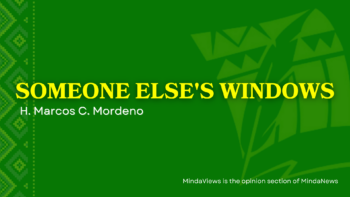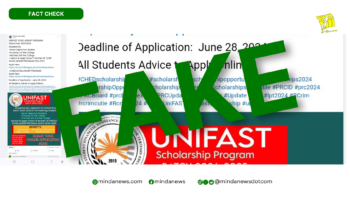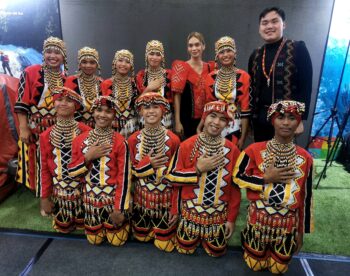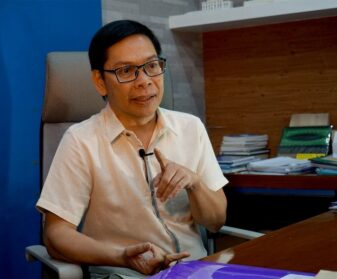
Family on a Journey
Christmas is a story of a family on a journey. The famous nativity scene in Bethlehem is nestled against a backdrop of two journeys made by the family of Jesus: one from Nazareth to Jerusalem before his birth, then another from Jerusalem to Egypt (and vice versa) after his birth. The places they journeyed to played significant roles in the completion of the narratives of the Messiah coming: he should come from the City of David (Jerusalem) from whom the Lord promised to establish His eternal kingdom, and the Messiah should experience first his Exodus (flight from Egypt) as the people of Israel of old experienced the saving power of YWH (not really directly referring to the State of Israel today).
I would like to believe then that the traditional images in the ‘belen’ in our homes and parishes is not a static model but also, by factoring their journey back and forth, revealed the dynamic model of every family. Every family relationship is dynamic. We are not stuck to each other, but our rapidly changing behaviors find its utmost acceptance in a family. We need to stick to each other in order to survive in this rapidly changing world.
It is on this dynamism that I celebrated my Christmas together with my family on wheels around the roads of largely Southern Mindanao.
It was a little past 4 a.m. of December 26 when I left my little rectory in Sumosumo, Tago, Surigao del Sur, not anymore for the Misa de Gallo, but for a long journey filled with uncertainties. My family (my father, sister, and brother’s family) decided to go to General Santos City (formerly known as Dadiangas) or GenSan and later to Lake Sebu (South Cotabato) for a holiday break. It means I have to catch up with them driving alone for about 450 kilometers with no definite place or time for meals.
At dawn when I left, the drizzling rain seemed to rejuvenate my weary soul. The road was quiet, perhaps after a long weekend revelry, and as I passed by the silhouette of Andap mountain ranges in San Agustin, I realized that deep down within me, I was looking for a ‘real’ Christmas celebration. While the dawn reminded me of immediate Christmas preparations, Andap reminded me of Lumad struggles for their ancestral land and self-determination.
The mystery of incarnation taught us that the birth of the Messiah commenced the work of integral salvation. It means that to truly welcome Christ, one must embrace his mission. I was quite aware already about this mission especially among Lumads in Andap. However, I felt the need to reconnect with my family again. It was also on December of 2020 when in a series of online red-tagging attacks, the picture of my family was included while we were having meals. It was captioned something to this effect: ‘the communist priest enjoying the money from the terrorists.’ I wasn’t really affected by it until my niece, about 9 years old that time, asked me, ‘Tito (uncle), am I an NPA?’ It was here that I found the roads of my ministry and my family merging.
I decided to go to Lingig, Surigao del Sur (my previous assignment) and visit friends there whom I already considered my family too. On that note, I can also avoid the terrible Agusan-Davao road along Rosario, Bunawan and partly of Trento. Breakfast in Lingig was superb especially when you feel at home. It was there that I spent my youthful energies in the physically challenging ministry. Unfortunately, their church building was rendered unusable now due to the major damages brought upon by the 7.6 magnitude earthquake last December 2 (10:36 p.m.).
From Lingig, I travelled to Davao City where a friend, upon a very short notice, graciously offered me lunch at a fastfood in Panacan. The two-hour stopover seemed eternity for us as we shared each other’s struggles amidst the challenges at our different ends.
On my way to GenSan, I made my last stopover in Inawayan, Sta.Cruz to visit my former religious family, the Rogationists, who are running a sub-parish there. There was only one priest there who happened to be my college formator (also my barber that time!). In no hurry, I spent time talking with him, sharing our experiences in the ministry, and touring around the church premises and the sacristy. His simplicity humbled me. His generosity inspired me. Then I drove finally to my destination, my family waiting for me in GenSan.
It was dusk already when I descended from Malungon (Sarangani Province), the sky greeting me with a fire-colored view. Everything was well when I arrived, like when I was a kid playing outside our home, catching my family at dinner time.
The Road
The following day, after a sumptuous breakfast with my Aunt Nep-nep (Papa’s 2nd cousin), we hit the road again, this time with Papa, Chito, and my nephew, Gerger, and niece, Hannah, as my passengers. They will be my passengers for the rest of the trip that would total about 1,200 kilometers (including mine) covering 10 provinces and two major cities of Southern Mindanao in three days.
We spent our second night in Lake Sebu (South Cotabato), then we took the road to Tacurong (Sultan Kudarat) on our way back to Davao region via Makilala (North Cotabato).
Technically, we spent more time on the road during our waking hours than the time we spent on sleep and meals.
All the roads that we passed through were already paved, except the one of the mountain resort overlooking Lake Sebu. However, all the concrete roads come in different width or lanes and even ‘roughness.’.Some roads are familiar to me being a traveler since I was a kid, tagging along my father’s seminars and meetings. Some roads evoke painful memories that I wish I would not have passed again. Some roads are happy memory lanes while other lanes are nostalgic. But roads are not end in themselves, they are simply a passage from one point to another. Driving through these roads with my loved ones is something that I would cherish for the rest of my life.
A few years back, roads in Mindanao were clear indicators of its economic situation. A Mindanawon undersecretary once quipped: ‘in Mindanao, where the good roads end, the problem begins’ (ADB 2017).
This year, there was another 2.4 billion worth of high-impact infrastructure projects to further enhance Mindanao’s inclusive growth. However, there seemed to be a disconnect when OCTA Research reported that Mindanao has the ‘highest percent of Filipinos who considered their families food-poor’ (Phil.Star 2023). In fact, according to the Philippine Statistical Authority (PSA) 16.4% or 4.1 million Filipinos lived below the poverty line (Rappler 2023).
Consistently, ever since, most of the poorest provinces in the country are found in Mindanao. Corruption issues connected with road projects are consistent, too. As we passed continuous road works, I can only wonder how much road budgets were really put into good use.
The Food
My family is quite diverse in terms of our passion but we all agree on good food. In GenSan, we feasted on fresh tuna products and enjoyed the local famed arroz caldo in Banga (South Cotabato). We enjoyed the different ways of tilapia cooking at Lake Sebu while we consumed fresh and cheap fruits products along the way. With the ubiquitous presence of convenience stores, we could easily stop for coffee or other drinks for the kids. We preferred to dine in local carenderias than in giant fast food restos.
With the vast arable areas in Mindanao, there ought not to have any problem on food security. But reports said that in 2023, Mindanao posted second in the whole country with the highest cases of hunger (Phil.Star 2023).
Pre-conquest Mindanao had no problem at all with its subsistence. The different ethnolinguistic groups here seemed to have a common worldview that nature sustains. Hence, nature should be respected. Colonization changed this concept radically when Mindanao became only the source of the raw materials by Imperial Manila. Since then, this region has suffered much until now. From the logging boom in the 1950’s to our present day woes with mining companies, there seemed to be an insatiable greed among capitalists, oblivious to the negative impacts on the local communities. With the Lumads, there is enough for everyone. In Laudato si’ 2015, Pope Francis denounced the technocratic paradigm that destroys God’s creation in the name of profit.
The Places
This trip might have brought me to different places I’ve been to but I’m always amazed by how rapidly changing these places have become. When I first arrived in Lingig (Surigao del Sur) for my pastoral exposure as a seminarian in 2006, I found an isolated town even if it was only 20 kilometers or more away from the nearest city of Bislig.
Today, Lingig boasts of its beautiful plaza and beaches with equally dependable paved road. Makilala in North Cotabato back in 1995 was known only for its rubber plantations and fruit products. Now, it is simply unrecognizable from its previous state.
The Southern Mindanao Regional Athletic Association (SMRAA) in 1993 brought me to GenSan when its first large mall was newly opened. Now GenSan has as much to offer as Davao or any other city in Mindanao. But the most remarkable development I observed is with Tagum city where, when I was a kid, it was only a little like Tandag. But now, without doubt it’s becoming a bustling metropolis.
At the outset, there seemed to be a genuine growth in the local economies in Mindanao. I don’t want, however, to measure it according to our economists who almost yearly adjust the calculation of the family daily living income or allowance.
In my parish, I’ve known families who just slept through their Christmas eve since they have nothing on the table for noche buena. Hence, the fundamental indicator for me is the food on the table and the extra money for non-food needs.
It is easy to be swayed by tall buildings, decent establishments, and beautiful resorts as indicative of stable economic growth. How on earth can I say that those places I’ve been too really progressed when the poverty incidence remained the same or even higher!
Looking closely, in Mindanao, those who benefited most are the multinational and transnational companies that practically extracted our natural resources starting from the time of the American occupation at the turn of the 20th century. Lately, there are still more multinational companies arriving with the help of corrupt local politicians and elite families of the Philippines. Investors’ mouthpiece are frothing with false promises of unprecedented economic development. Caraga region has remained poor despite being the mining capital of the Philippines. Unfortunately, the mining industry continues to threaten the food security of the local communities in Mindanao. Amidst the natural beauty of Lake Sebu, there remains a threat of open-pit coal mining and agro-business by Filipino-owned businesses (Rappler 2022).
When I thought that the very people of Mindanao will benefit from the promise of its land, the reality tells otherwise. This is true even among local businesses which are predominantly owned by local politicians. Yes, politicians are owners, too, of big businesses in the very areas they are serving. This idea was unthinkable a few decades ago out of delicadeza. But the reality is right under our noses now as complained by Mayor Benjamin Magalong of Baguio City. Before, one only gives a payola to an incumbent mayor or governor. Now, imagine a local executive awarding a project to his/her own business firm. He/she not only takes the lion’s share but also kills the duck that that proverbially lays the golden egg.
The People
The people of Mindanao are diverse. It is here where you can find people from all the regions of the Philippines. Traveling around makes you encounter them firsthand. Ma’am Gemma in Lingig came from Leyte. Diane, whom I spent lunch with is a third generation migrant from Iloilo. The late husband of my Aunt Nepnep was a businessman from Manila. The father of my friend Ninoy hailed from Villasis, Pangasinan. Resort staff came all the way from Cebu. And of course, my great great great maternal grandfather came all the way from Bohol while Papa’s maternal grandfather came from central Cebu.
When you are in Mindanao, the most usable language is Cebuano. But in every Cebuano-speaking place in Mindanao, there is a new twist of Cebuano language. Being born in Cebu City and learning my language there, I still take a lot of adjustments and creativity to be conversant in Mindanao. In the areas that we’ve been to, Cebuano is understandable but people mostly speak Hiligaynon, commonly known as Ilonggo language. Filipino language or predominantly Tagalog remained universally understood here also but sometimes it pushes people away especially when they don’t know how to respond. Hannah, my niece, was confused when I casually shifted from Cebuano, Hiligaynon, and Tagalog while conversing with different people. Different ethnolinguistic groups found themselves adaptable to the language of the local migrants. The Manobos and Mamanwas in Agusan and Surigao fluently speak Cebuano. The Blaan and Tboli in South Cotabato that I met were Ilonggo speakers.
The post-war influx of inmigration in the 1950’s has perfected the American policy of benevolent assimilation of Mindanao during the commonwealth era. Family of farmers from Luzon and Visayas flocked to Mindanao as the Land of Promise. Yet, the promise remained elusive after seven decades.
The eager local migrants who were mostly farmers ended up in conflict with Moro residents. On the other hand, until now, most migrants who are employed by multinational companies rendered cheap labor — be it in farms, plantations, resorts, or in malls. Hence, most of the nth generation migrants aim to migrate also to foreign countries for other greener pastures.
There are 26 million people in Mindanao, (PSA 2020) with 19 million Christians, 5.1 million Moro, and 2.6 millions Lumads (Mindanao Climate Justice Resource Facility 2023). There are diverse belief-systems also among the population with the Lumads mostly adapting to any Christian denominations.
Religion is a factor to the peace and order problem in Mindanao. But unlike before, I feel that there are more Moro and Christians who connect than stick to their differences. We have found more common grounds than broken bridges. As the song goes, ‘persons are gifts, wrapped differently.. but wrappers are not gifts’. The relationship of Lumads, migrants, and the Moro people are constantly evolving, hopefully for a deeper realization of our common humanity. The coming of the Messiah dignifies every family and every person.
The Home
It was already midnight when we reached Hinatuan (Surigao del Sur) to pick up something before finally heading home. Hinatuan was once my home as it was my first pastoral assignment. As we headed for our house in Tandag, I had an ambivalent feeling of what home really is for me and where it is then.
From the three cars in convoy, we reduced to two as my sister opted to stay in Davao City for a reason. I wasn’t that excited to go home since were not complete anymore. But I remembered at a souvenir shop in Lake Sebu and elsewhere, in our conversations, we always mentioned Mama who passed away about 10 years ago. What would her comments be? What kind of food would she order? Would she be comfortable with our accommodations? What would she buy at the shop? What would she tell my niece or nephew?
It gradually dawned on me then that our journey together as a family was a search or a longing for Mama’s presence. It was a proverbial elephant inside the room. Mama was life of the family. She made us all laugh and inspired us to do better. We felt being looked after. She had always a solution for every problem we faced. She reminded me of my lab appointments. She was my pre-paid loader even when I was a priest already!
When she was gone, it was the most painful thing that ever happened to each of us. Since we were not emotional individuals, we just moved on our different ways even if we knew we were hurting. That Christmas outing was our first time to be together again without Mama. We managed to laugh again, share our ideas and opinions, and accept each other’s idiosyncrasies. Mama will never be with us anymore but she wasn’t the missing piece of the puzzle any longer in our family.
Mothers don’t die. They just continue living through us. We developed our special relationship with Papa who was distant from us then. Our journey together made us realize that we still have each other. That’s what a family is. Home is not a destination after all. It is the journey. The Holy Family is always in a journey to teach us that it is by journeying together that we become a family.
The image of the Holy Family in the nativity scene should remind us that every family is connected to one another. When the Holy Father, Francis, reminded us that we cannot celebrate the birth of the Prince of Peace, if we support war, our Christmas celebration should dispose us to support the mission of the Messiah. Our care for families should extend even to the stricken families of Gaza and the victims of Hamas. The Lord came down to journey with us and lead us to the fullness of life. So long as there are people oppressed, suffering from mental stress, abused and exploited, discriminated, etc., the mystery of incarnation continues to challenge our way of celebrating Christmas.
Happy Feast of the Holy Family!!
(MindaViews is the opinion section of MindaNews Fr. Raymond Montero Ambray heads the Integral Ecology Ministry, LGBTQ+ Apostolate, Church Heritage and Historical Commission of the Diocese of Tandag. He finished Theology at the Don Bosco Center of Studies and is a graduate of MA Anthropology at the Ateneo de Davao University, a member of the Rural Missionaries of the Philippines and a founding member of Caraga Watch, an environmental watchdog. He is part of the Board of Consultors of the Bishop of Tandag. This reflection was first published on his FB page. MindaNews was granted permission to publish this)







